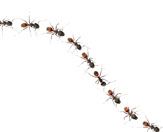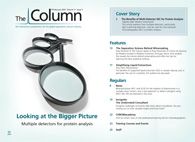Investigating Insect Communication with HPLC-ELSD
Page 8
(Image Credit: arlindo71/Getty Images)

Scientists have published a novel method using reversed-phase high performance liquid chromatography (HPLC) with evaporative light scattering detection (ELSD)
for the isolation and determination of nonvolatile methyl-branched hydrocarbons (MBCHs) from insect cuticles.1 The method opens up the opportunity to investigate the importance of nonvolatile contact MBCHs to insect communication, which could aid the development of nontoxic methods of controlling pest insects.
There are two classes of compounds that are used by most insect species for communication: vola
tile pheromones for long distances and nonvolatile pheromones for contact. It has been previously established that chirality is important to the production of volatile pheromones - one enantiomer can be attractive to one species but repulsive to another - but not a lot is known about the role of chirality to contact pheromones. MBCHs are generally used for close-recognition of species and sex, for example, Queen ants and bees can use MBCHs to control colonies by ensuring that other females are not fertilized. Corresponding author Jocelyn G. Millar from the University of California, USA, told The Column: “In short, insects are often very good at both making and detecting different stereoisomers of volatile pheromones. We wanted to see whether this carries over to nonvolatile pheromones that act only at close range or on contact, such as the methyl-branched hydrocarbons (MBHs).”
MBCHs are found within the insect cuticle (along with many other insect cuticular lipids), and so the separation and isolation of MBCHs can be challenging. The team developed a method to isolate 36 pure MBCHs from the cuticles of insects from 20 species selected at random. Crude extracts of insect cuticular lipids were fractionated to separate out the hydrocarbons, and were then separated by reversed-phase HPLC, using an ELSD to detect nonvolatile molecules to further isolate the MBCHs. Of the MBCHs identified, all had the same configuration indicating conservation of the biosynthetic pathway throughout the Insecta.1 Millar told The Column: “Our results so far have given us part of the answer, that is, all the insects that we analyzed produced only (R)-enantiomers of MBCHs. Now, the follow-up part of the work is to test the two enantiomers to determine whether different species can detect the difference between the two enantiomers (preliminary results indicate that they can).”
Millar concluded: “The organization of the tens to millions of individuals that live in a single colony is largely controlled by chemical signals. Thus, by artificially increasing the amounts of some of those signals, or by skewing the ratios, it may be possible to disrupt the colony, causing it to decrease in size or collapse altogether. These sorts of strategies could form a novel, completely nontoxic method of controlling pest insects such as ants, wasps, and termites.” - B.D.
Reference
1. J.E. Bello, J. Steven McElfresh, and J.G. Millar, PNAS Early Edition DOI: 10.1073/pnas.1417605112 (2015).
This article is from The Column. The full issue can be found here>>

Thermodynamic Insights into Organic Solvent Extraction for Chemical Analysis of Medical Devices
April 16th 2025A new study, published by a researcher from Chemical Characterization Solutions in Minnesota, explored a new approach for sample preparation for the chemical characterization of medical devices.
Sorbonne Researchers Develop Miniaturized GC Detector for VOC Analysis
April 16th 2025A team of scientists from the Paris university developed and optimized MAVERIC, a miniaturized and autonomous gas chromatography (GC) system coupled to a nano-gravimetric detector (NGD) based on a NEMS (nano-electromechanical-system) resonator.
Miniaturized GC–MS Method for BVOC Analysis of Spanish Trees
April 16th 2025University of Valladolid scientists used a miniaturized method for analyzing biogenic volatile organic compounds (BVOCs) emitted by tree species, using headspace solid-phase microextraction coupled with gas chromatography and quadrupole time-of-flight mass spectrometry (HS-SPME-GC–QTOF-MS) has been developed.
A Guide to (U)HPLC Column Selection for Protein Analysis
April 16th 2025Analytical scientists are faced with the task of finding the right column from an almost unmanageable range of products. This paper focuses on columns that enable protein analysis under native conditions through size exclusion, hydrophobic interaction, and ion exchange chromatography. It will highlight the different column characteristics—pore size, particle size, base matrices, column dimensions, ligands—and which questions will help decide which columns to use.











